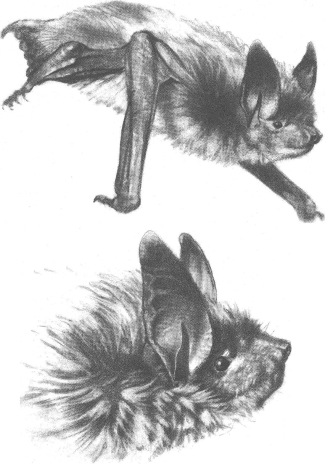Reproductive data for the province are also scanty, consisting of anecdotal observations and information on museum specimens. Mating presumably occurs in autumn or early winter; females produce a single young. Pregnant females were found in a maternity colony at Vermilion Crossing, Kootenay National Park, between 28 June and 7 July. In the Okanagan Valley, females with near-term foetuses were collected on 27 and 28 June, and nursing females were observed from 5 July to 13 August. These data suggest that, in the interior, young are born in late June or early July. No reproductive data are available for coastal British Columbia. Newborn Western Long-eared Myotis are furless and weigh 1.0-1.5 grams.
|
Western Long-eared Myotis typically emerge 10 to 40 minutes after dark to feed. It is quite flexible in its feeding behaviour, eating airborne insects as well as gleaning insects from vegetation or off the ground. Food habits have not been studied in British Columbia; in other regions, it is known to prey mainly on moths, as well as beetles, flies and spiders. Robert Barclay has suggested that bat's flexible feeding behaviour enables females to breed successfully in high, cool sites where flying insects are scarce. Its quiet, short-duration, high-pitched echolocation calls are an adaptation for hunting in habitats with heavy vegetation. Furthermore, these calls are not readily detected by most moths. When closing in for an attack, the Western Long-eared Myotis often stops calling and listens for sounds produced by its prey. Moths may be especially vulnerable to predation by the Western Long-eared Myotis because their fluttering is audible.
|
In summer the Western Long-eared Myotis uses buildings or under the bark of trees as day roosts; there are also a few records of this species roosting in caves, sink holes and fissures in cliffs. Maternity colonies, usually located in buildings, are generally small (5 to 30 individuals) and may contain a few adult males. Caves and mine adits are used as temporary night roosts.
There are no winter records for the province; in fact, this bat's winter biology is poorly documented throughout its range. In the western United States, a few individuals have been found hibernating in caves and mine adits and there is a December record from coastal Oregon of an individual that was found in a garage.
|
|


